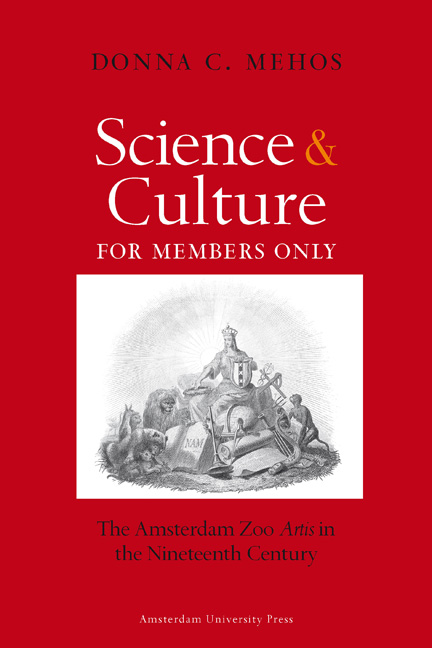Book contents
- Frontmatter
- Dedication
- Contents
- Acknowledgments
- Introduction The Nation and Nature in Middle-Class Culture
- Chapter 1 Structuring a New Generation’s Scientific Society
- Chapter 2 Private Science and the Public Interest
- Chapter 3 Internationalizing Nationalist Science
- Chapter 4 Science Joins Cultural Life
- Conclusion Science, Colonial Expansion, and National Identity
- Appendix: Members of the Artis Board of Directors, 1838-1870
- Notes
- List of Illustrations and Color Plates
- Bibliography
- Index
- Plate Section
Introduction The Nation and Nature in Middle-Class Culture
Published online by Cambridge University Press: 20 January 2021
- Frontmatter
- Dedication
- Contents
- Acknowledgments
- Introduction The Nation and Nature in Middle-Class Culture
- Chapter 1 Structuring a New Generation’s Scientific Society
- Chapter 2 Private Science and the Public Interest
- Chapter 3 Internationalizing Nationalist Science
- Chapter 4 Science Joins Cultural Life
- Conclusion Science, Colonial Expansion, and National Identity
- Appendix: Members of the Artis Board of Directors, 1838-1870
- Notes
- List of Illustrations and Color Plates
- Bibliography
- Index
- Plate Section
Summary
No one can say I don't live decently with my wife – she is a daughter of Last & Co., coffee brokers – no one can find fault with anything in our marriage. I am a member of “Artis”, she has a shawl which cost ninety-two guilders…
– Multatuli, Max HavelaarWith these words, the fictional Amsterdam coffee broker, Batavus Droogstoppel, positioned himself in decent Dutch society. Portrayed as the caricature of an unfeeling intolerant hypocrite, Droogstoppel represented one segment of Dutch middle-class society in Amsterdam. A trader of colonial wares who married into a respectable family, he also confirmed his identification with polite society by pointing out his membership in the private Zoological Society (Zoologisch Genootschap) Natura Artis Magistra – the Amsterdam zoo.
Science, the Zoo, and Middle-Class Culture
Clearly, for the Dutch who read Max Havelaar when it appeared in 1860, Artis membership was a recognizable status symbol. Artis emerged as a significant cultural institution devoted to science. It was founded by and for its middle-class members. Historians of the nineteenth century have rarely included zoos or science in their analyses of the rise of bourgeois culture in which art museums and concert halls figure more prominently. Yet in the Netherlands, the two Dutch national art museums struggled for both financial support and public recognition in a period when Artis was prospering.
While public art museums rarely received donations and the art market valued seventeenth-century paintings by Frans Hals or Vermeer in the hundreds (rather than thousands or millions) of guilders, Artis regularly received gifts and easily purchased exotic animals at costs comparable to masterpieces. Artis operated with an annual budget that the art museum directors would have considered astronomical. If money talks, these figures tell us that, in the nineteenth century, exotic animals, ethnographica, and natural history at the multi-functional zoological society was much more highly esteemed by Amsterdam's cultured middle classes than the Rem brandts and Jan Steens that have come to symbolize the nation's cultural heritage.
This history of Artis investigates ideals and expressions of bourgeois culture (burgerlijke cultuur). Te Velde and Aerts have described the bourgeoisie in the Netherlands as driven by a perceived obligation to live productive lives, and to contribute to society and to the progress of national culture.
- Type
- Chapter
- Information
- Science and Culture for Members OnlyThe Amsterdam Zoo Artis in the Nineteenth Century, pp. 11 - 20Publisher: Amsterdam University PressPrint publication year: 2006



